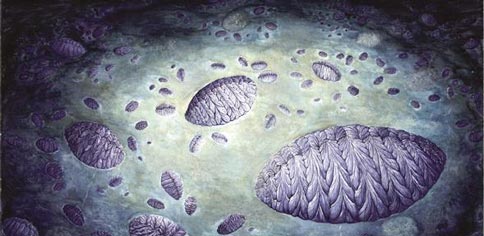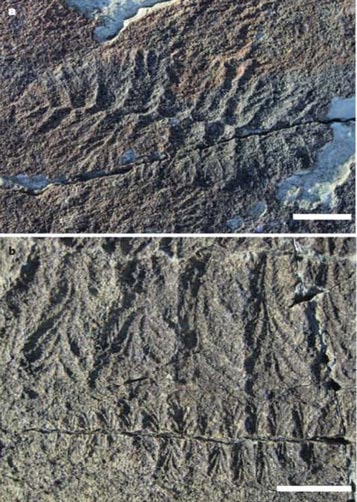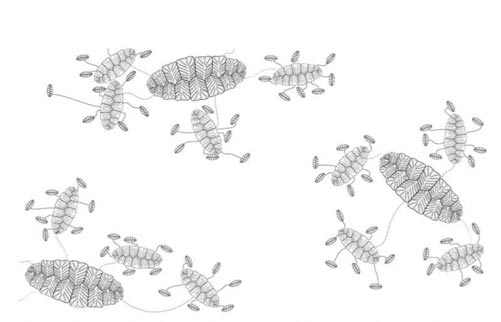Earliest Evidence of Reproduction in a Complex Organism
Unravelling the Secrets of Fractofusus
There has been much debate over the origins of life on Earth and over the last two decades our understanding of that “slow burning fuse” leading to complex multi-cellular life forms has greatly improved, but many mysteries still remain. During the latter stages of the Proterozoic Eon, referred to as the Neoproterozoic, the very first ecosystems were established with bacteria, algae and protists (single-celled organisms with a nucleus), still dominating but slowly and surely more complex life began to evolve and to play an increasingly important role in these food webs.
Earliest Example of Reproduction in a Complex Organism
A team of scientists led by researchers from Cambridge University have identified the earliest example of reproduction in a complex organism, opening a window into life in deep water marine environments some 565 million years ago.
An Illustration of the Bizarre Ediacaran Fauna Fractofusus
Picture credit: Cambridge University
Fractofusus – Two Species
Fractofusus (two species F. misrai and F. andersoni) was the organism studied. Fractofusus, which belonged to a group of bizarre organisms that show links to both the Plantae and Animalia Kingdoms called Rangeomorphs, thrived in marine habitats during the Ediacaran, a geological period that marked the end of the Proterozoic Eon, that lasted from around 635 million years ago to 542 million years ago.
Ediacaran fauna represent a transition from the microbially dominated food chains of the early Earth towards the modern biota that can be identified in Cambrian fossils.
More than thirty different Ediacaran faunal types have now been described providing scientists with the oldest known record of diverse, complex creatures. Fossils of these ancient communities have been found in Russia, the Ediacaran Hills of South Australia (from which this geological period was named) and in Canada (Newfoundland and Labrador). The Fractofusus fossils in this study come from the Mistaken Point Ecological Reserve on the coast of Newfoundland.
Fractofusus
The research team discovered that Fractofusus took a bilateral approach to reproduction. These lozenge shaped fossils were benthic (live on the sea floor) and sessile (attached to rocks), in addition, they were not mobile. This means that fossils showing these strange organisms preserve them in situ, as they would have been when they were alive. If an area is dotted with these fossils, then the scientists have a spatial map of how these organisms were distributed. It is from these spatial maps that ideas about their reproduction strategy can be inferred.
Looking like fern fronds, Fractofusus was related to Charnia masoni, fossils of which were first identified from rocks exposed at Charnwood Forest in Leicestershire (Midlands of England). These bizarre life-forms probably lived in deep water, far below the Epipelagic Zone of the ocean (the first two hundred metres of sea, where sunlight can penetrate).
At depth, no sunlight could reach, so these organism were not true plants as they could not photosynthesize. They are difficult to place in the Kingdom Animalia as well. They were fractual forms, with frond-like structures with no mouths, alimentary canal, anus or any method of locomotion. It is likely that their large surface areas, (some of these organisms were up to two metres in length), allowed them to absorb nutrients directly from the sea water. They probably grew extremely slowly.
Fractofusus Fossils Used in the Study
Picture credit: Cambridge University
Dominating the Fossil Assemblage
Fractofusus colonies dominate the fossil assemblage found along the coast of Newfoundland. Two main species were analysed in this study. Firstly, there is the more oval form (a) F. andersoni, pictured above and then there is the elongate form Fractofusus misrai (b). Both these species exhibit the typical structures of this ancient organism, as preserved in the negative, epirelief external moulds formed in silts which were covered in volcanic ash deposits.
Analysis of the cluster patterns of the fossils revealed the likelihood of two methods of reproduction. In one method, the organism sprouted “runners” from its body similar to the stolons produced by plants such as strawberries (asexual reproduction). The second reproduction method (asexual or sexual reproduction), involved the release of waterborne propagules (simple buds or seeds released into the water column).
Able to Rapidly Colonise Areas
Such reproduction habits would have allowed this immobile organism to rapidly colonise a local area as well as to move to new territory. The capacity of Fractofusus to derive the next generation by two distinct reproductive modes is a testament to its sophisticated biology.
Unfortunately, Fractofusus seems to have become extinct during the start of the Cambrian geological period around 542 million years ago, a time when more complex organisms were involving including animals with hard shells and armour with the establishment of the first complex predator/prey based ecosystems.
A Diagram Illustrating How Fractofusus Spread
Picture credit: Cambridge University
Dual Method of Reproduction
The dual method of reproduction is illustrated in the above diagram. Larger “grand-parent” organisms were the product of ejected waterborne propagules, while the “parents” and “children” grew from stolon like structures sent out by the older generation.
Lead author of the scientific paper, which has just been published in the journal “Nature”, Dr. Emily Mitchell (Cambridge University) stated:
“It [Fractofusus] has a very distinct body plan that is totally unique. There is nothing like Fractofusus around today, which makes trying to understand anything about it really, really difficult. We knew very little about it, apart from the fact that it lived in the deep sea, it has a relatively large surface area, so it got its nutrients from the water column. We literally had no idea how it reproduced prior to this study.”
Dr Mitchell went onto add:
“Fractofusus doesn’t exhibit any of the features you associate with animals. It certainly wasn’t a plant. It belonged to a now extinct eukaryotic group known as Rangeomorphs. But how Rangeomorphs relate to animals and the origins of animals is incredibly difficult to work out.”
This statistical, spatial mapping approach to the study of Ediacaran fauna is in its infancy. The research team hope to employ this technique to explore how Fractofusus interacted with its environment and how colonies interacted with each other.
Visit Everything Dinosaur’s award-winning website: Everything Dinosaur.




